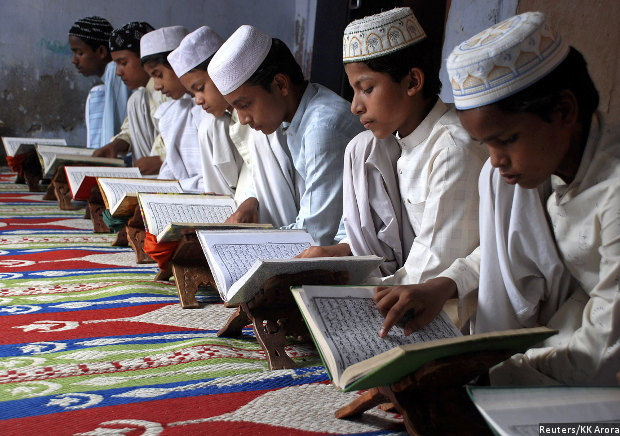Modernising Madrasas: Govt Spends Rs 1,000 Cr In 7 Years
Muslim children read the Koran at a madrasa in the northern Indian city of Mathura. The government increased the spending on the Scheme for Providing Quality Education in Madrasas (SPQEM), launched in 2009-10, from Rs 46 crore to Rs 294 crore–a five-fold increase.
The central government has spent over Rs 1,000 crore over seven years to modernise madrasas (an Arabic word for educational institutions) or Islamic educational institutions, according to data released by Minister for Human Resource Development Prakash Javadekar to the Lok Sabha (lower house of Parliament) on August 1, 2016.
Source: Ministry of Human Resource Development
The government increased the spending on the Scheme for Providing Quality Education in Madrasas (SPQEM), launched in 2009-10, from Rs 46 crore to Rs 294 crore--a five-fold increase. Spending almost tripled in one year--2015-16--to Rs 294 crore from Rs 108 crore in the previous year.
"Under the scheme (SPQEM), financial assistance is provided to encourage traditional institutions like madrasas and maktqabs to introduce modern education in subjects such as science, mathematics, social studies, Hindi and English in their curriculum through support for teachers, books, teaching learning materials and computer labs," the minister said in his reply to the Lok Sabha.
UP madrasas received maximum funds
Over 48,000 madrasas in Uttar Pradesh (UP) received financial assistance during the last seven years--the highest amongst all states--followed by Madhya Pradesh and Kerala.
Source: Ministry of Human Resource Development;Figures for the period 2009-10 to 2015-16
While UP saw an increase of 62% in the number of madrasas supported in 2015-16 over the previous year (from 9,217 to 14,974), Bihar witnessed a jump of 13 times (from 80 to 1,127).
Madrasa students are predominantly Muslims, who reported the largest increase in literacy--9.4 percentage points, from 59.1% in 2001 to 68.5% in 2011--among India’s minorities, IndiaSpend reported on July 26, 2016.
Despite almost trebling in the decade ending 2010—from 5.2% to 13.8%—the rate of Muslim enrolment in higher education trailed the national figure of 23.6%, other backward classes (22.1%) and scheduled castes (18.5%), IndiaSpend reported on July 22, 2016.
"Since 1993, there has been a madrasa modernisation policy, primarily designed for azad madrasas. The idea was to convince them to teach modern subjects in lieu of state grants for books and additional teachers," wrote Arshad Alam, an assistant professor at Delhi's Jawaharlal Nehru University, in The Indian Express on July 25, 2015.
"But the policy treated madrasas as homogeneous, so grants were also cornered by state-funded madrasas," wrote Alam. "Also, a majority of the grants to azad madrasas have been utilised to hire part-time untrained teachers, which defeats the purpose of introducing quality education in these institutions. To top it all, madrasas affiliated to Deobandis and Ahl-e-Hadis completely refused to take part in this initiative."
We welcome feedback. Please write to respond@indiaspend.org. We reserve the right to edit responses for language and grammar.
__________________________________________________________________
Liked this story? Indiaspend.org is a non-profit, and we depend on readers like you to drive our public-interest journalism efforts. Donate Rs 500; Rs 1,000, Rs 2,000.



